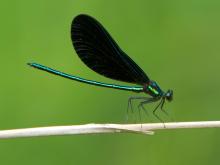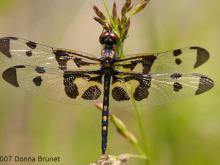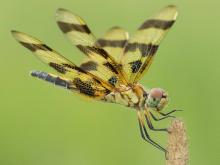Land Invertebrates
Media

Species Types
Scientific Name
About 20 species in North America north of Mexico
Description
Scoliid wasps are a family of beetle hunters. Large, rather hairy wasps, some are handsomely colored. The female digs in soil, finds a scarab beetle grub, and lays an egg on it.
Media

Species Types
Scientific Name
Glenurus gratus
Description
The antlion known to science as Glenurus gratus ought to be called the pleasing antlion, but it has no formal common name.
Media

Species Types
Scientific Name
Meloe spp.
Description
Blister beetles in the genus Meloe are called oil beetles because of a yellowish oil they excrete from their joints when squeezed or distressed. This oil contains cantharidin, an irritating chemical that can cause blistering in many people.
Media

Species Types
Scientific Name
Calopteryx maculata
Description
The ebony jewelwing is a beautiful iridescent green or turquoise damselfly with large black wings. It flutters around streams in wooded areas.
Media

Species Types
Scientific Name
Libellula luctuosa
Description
The widow skimmer has distinctive dark wing markings that seem like mourning garb. Mature males have white areas in the center of their wings, beside the dark patches, while females and immature males lack the white patches.
Media

Species Types
Scientific Name
Celithemis fasciata
Description
The banded pennant is a small dragonfly (to about 1½ inch long) with distinctive black markings and reddish eyes.
Media

Species Types
Scientific Name
Gomphurus vastus
Description
The cobra clubtail is in the family of dragonflies called clubtails, named for the enlarged abdomen tip. There are about 100 species in this dragonfly family in North America north of Mexico.
Media

Species Types
Scientific Name
Celithemis elisa
Description
The calico pennant is a colorful, beautifully marked dragonfly. Males have pink wing veins and females have yellow. Males have a row of bright reddish heart-shapes on the abdomen; females have yellow.
Media

Species Types
Scientific Name
Celithemis eponina
Description
The Halloween pennant is one of the more common members of its genus. Distinctive wing markings include a complete brown band (not just a spot) positioned just short of the wing tip.
Media

Species Types
Scientific Name
Pachydiplax longipennis
Description
Blue dasher males and females look quite different. Both have a white face, a black abdomen tip, and slanted black and yellow stripes on the thorax. But males are blue and females are striped black and yellow.
See Also



Media

Species Types
Scientific Name
Cisseps fulvicollis
Description
The yellow-collared scape moth is more often “orange-collared.” And whether you think it looks more like a firefly or a wasp, it’s still a moth!
Media

Species Types
Scientific Name
Nearly 150 species in North America north of Mexico
Description
Slim, delicate plume moths are instantly recognizable by their T-shaped silhouette, long legs, and muted shades of tan and brown. It can be hard to separate the various species.
Media

Species Types
Scientific Name
Pyrrharctia isabella
Description
Not many people know the adult Isabella tiger moth when they see one, but we’re all acquainted with its caterpillar, the woolly worm, or woolly bear.
About Land Invertebrates in Missouri
Invertebrates are animals without backbones, including earthworms, slugs, snails, and arthropods. Arthropods—invertebrates with “jointed legs” — are a group of invertebrates that includes crayfish, shrimp, millipedes, centipedes, mites, spiders, and insects. There may be as many as 10 million species of insects alive on earth today, and they probably constitute more than 90 percent all animal species.





















